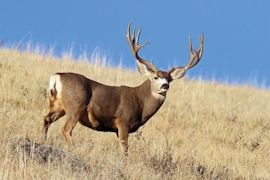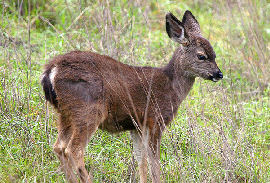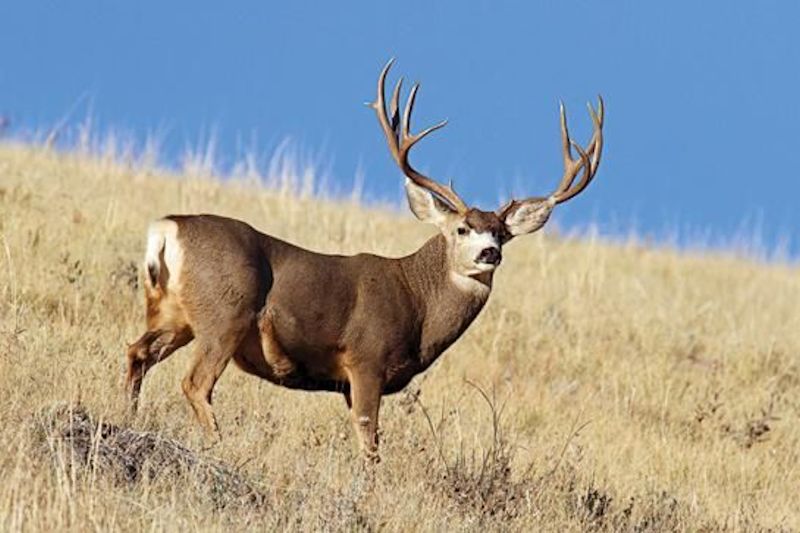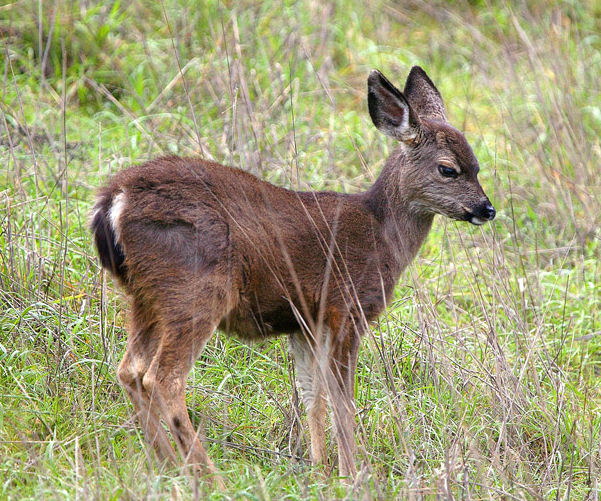Hoofed Mammals
Description
A medium-size deer. Stocky body, with long, slim, sturdy legs. In summer, reddish brown or yellowish brown above; in winter, grayish above. Throat patch, rump patch, insides of ears, and insides of legs are white; lower parts cream to tan. Large ears. Buck’s antlers are branched equally, each a separate beam forking into 2 tines; antler spread to 4’ (1.2 m). 2 major types: Mule Deer, the more common, has tail white above and tipped with black. "Black-tailed Deer," found only along Pacific Coast, has tail blackish or brown above. Juvenile spotted. Ht 3’–3’5" (90–105 cm); L 3’10"–7’6" (1.16–1.99 m); T 4 1/2–9" (11.4–23 cm); E 4 3/4–6" (12–15 cm); Wt male 110–475 lb (50–215 kg), female 70–160 lb (32–73 kg).
Similar Species
White-tailed Deer has antlers with 1 main beam; tail is not tipped with black.
Breeding
Breeds from autumn through early winter; after gestation of 6–7 months, 1–2 young born June–August. Newborn weighs about 8 lb (3.6 kg).
Sign
Browse marks, buck rubs, scrapes, bed, and
droppings similar to those of White-tailed Deer.
Bed: Examination
often reveals sex: Both urinate upon rising, but doe first steps to
one side; buck urinates in middle of bed.
Tracks: Foreprint and
hindprint like narrow split hearts, with pointed end forward. Male
prints 3 1/4" (80 mm) long, female 2 3/8" (60 mm) long; walking
stride 22–24" (550–600 mm). Distinctive bounding gait ("stotting"),
with all 4 feet coming down together, forefeet printing ahead of
hindfeet.
Discussion
The Mule Deer has large ears that move independently and almost constantly, like a mule’s. Primarily active in morning, evening, and on moonlit nights, this deer may also be seen at midday in winter. The Mule Deer has a stiff-legged bounding gait, with back legs and front legs, moving together. It is also a good swimmer. In mountainous areas, the animal migrates up and down seasonally to avoid heavy snows. Its summer forage is chiefly herbaceous plants, but also blackberry, huckleberry, salal, and thimbleberry; winter browse includes twigs of Douglas fir, cedar, yew, aspen, willow, dogwood, serviceberry, juniper, and sage. This deer also eats acorns and apples.Mule Deer often form herds of both sexes in winter, but herds are seldom large. The usual social group consists of a doe with her fawn or a doe with twin fawns and a pair of yearlings. When does encounter each other, they often fight, so family groups space themselves widely, thereby helping to ensure food and cover for all. Many bucks are solitary, but some band together before and after the rutting season. The buck has a larger home range than the doe; during the rutting season both buck and doe may leave their home range. The buck is polygamous and seeks out does in estrus, sometimes trying to herd them. A male may breed with most does in his area, and a doe probably breeds with several males. Displays and threats often prevent actual conflict between bucks, but vigorous fights do occur, in which each tries, with antlers enmeshed, to force down the other’s head. Even in such battles, injuries are rare; usually the loser withdraws. If antlers become locked, both animals perish through starvation. A first-year doe produces a single fawn, while an older doe usually has twins. For their first month, the young are kept concealed; their mother visits them regularly to nurse. The Mule Deer has glands on the hindlegs above the hooves. A fawn seems able to recognize its mother by the odor from these glands, and when deer are in groups, they frequently sniff these glands. The long hairs around the glands usually become erect when aggressive confrontations between bucks begin.
Mountain Lions and wolves are the major natural predators. Bobcats and bears take a few, and Coyotes take juveniles; others are killed by trains and automobiles. Prized as a trophy and for its flesh, this deer is hunted by humans. Mule Deer can cause damage to crops and timber.




